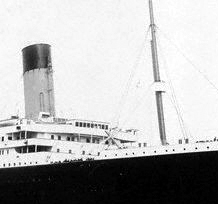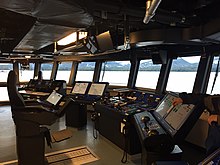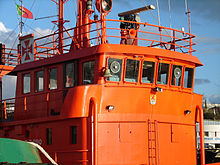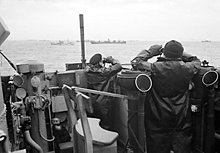
Seamanship is the art, knowledge and competence of operating a ship, boat or other craft on water. The Oxford Dictionary states that seamanship is "The skill, techniques, or practice of handling a ship or boat at sea."

A cockpit or flight deck is the area, on the front part of an aircraft or spacecraft, from which a pilot controls the aircraft.

The Mersey Ferry is a ferry service operating on the River Mersey in north west England, between Liverpool to the east and Birkenhead and Wallasey on the Wirral Peninsula to the west. Ferries have been used on this route since at least the 12th century, and continue to be popular for both local people and visitors.
Piloting or pilotage is the process of navigating on water or in the air using fixed points of reference on the sea or on land, usually with reference to a nautical chart or aeronautical chart to obtain a fix of the position of the vessel or aircraft with respect to a desired course or location. Horizontal fixes of position from known reference points may be obtained by sight or by radar. Vertical position may be obtained by depth sounder to determine depth of the water body below a vessel or by altimeter to determine an aircraft's altitude, from which its distance above the ground can be deduced. Piloting a vessel is usually practiced close to shore or on inland waterways. Pilotage of an aircraft is practiced under visual meteorological conditions for flight.

USCGC Eagle (WIX-327), formerly the Horst Wessel and also known as the Barque Eagle, is a 295-foot (90 m) barque used as a training cutter for future officers of the United States Coast Guard. She is one of only two active commissioned sailing vessels in the United States military today, along with USS Constitution which is ported in Boston Harbor. She is the seventh Coast Guard cutter to bear the name in a line dating back to 1792, including the Revenue Cutter Eagle.

A screw sloop is a propeller-driven sloop-of-war. They were popularized in the mid-19th century, during the introduction of the steam engine and the transition of fleets to this new technology.

The MV Andrew J. Barberi is one of two Barberi-class ferry boats operated as part of the Staten Island Ferry between Manhattan and Staten Island in New York City, besides MV Samuel I. Newhouse. With a capacity of 6,000, she is among the highest-capacity boats in the ferry's fleet. Since her introduction in 1981, she has had a history of incidents, including a 2003 crash that killed eleven people and a 2010 crash that injured thirty-seven.

A fishing trawler is a commercial fishing vessel designed to operate fishing trawls. Trawling is a method of fishing that involves actively dragging or pulling a trawl through the water behind one or more trawlers. Trawls are fishing nets that are pulled along the bottom of the sea or in midwater at a specified depth. A trawler may also operate two or more trawl nets simultaneously.
This glossary of nautical terms is an alphabetical listing of terms and expressions connected with ships, shipping, seamanship and navigation on water. Some remain current, while many date from the 17th to 19th centuries. The word nautical derives from the Latin nauticus, from Greek nautikos, from nautēs: "sailor", from naus: "ship".

RMS Segwun is the oldest operating steam driven vessel in North America, built in 1887 as Nipissing to cruise the Muskoka Lakes in the Muskoka, Ontario, Canada, a resort area with many lakes and rivers. Early in the 20th century, Muskoka was poorly served by roads. Vacationers were transported to lodges, or private cottages, via a fleet of steamships. Segwun is the oldest of only three ships in the world still carrying the status of Royal Mail Ship, and the only steamer.

A conning tower is a raised platform on a ship or submarine, often armoured, from which an officer in charge can conn the vessel, controlling movements of the ship by giving orders to those responsible for the ship's engine, rudder, lines, and ground tackle. It is usually located as high on the ship as is practical, to give the conning team good visibility of the entirety of the ship, ocean conditions, and other vessels.

A chief mate (C/M) or chief officer, usually also synonymous with the first mate or first officer, is a licensed mariner and head of the deck department of a merchant ship. The chief mate is customarily a watchstander and is in charge of the ship's cargo and deck crew. The actual title used will vary by ship's employment, by type of ship, by nationality, and by trade: for instance, chief mate is not usually used in the Commonwealth, although chief officer and first mate are; on passenger ships, the first officer may be a separate position from that of the chief officer that is junior to the latter.

The deck department is an organisational team on board naval and merchant ships. The department and its manning requirements, including the responsibilities of each rank are regulated within the STCW Convention, applicable only to the merchant fleets of countries who have ratified it. The department is led by deck officers, who are licensed mariners, and they are commanded overall by the ship's captain. Seafarers in the deck department work a variety of jobs on a ship or vessel, but primarily they will carry out the navigation of a vessel from the bridge. However, they are usually also responsible for supervising and monitoring any maritime cargo on board, as well as ensuring maintenance of the deck and upper hull structure, monitoring the stability of the ship, including loading and discharging ballast water, carrying out mooring operations, and finally anchoring a ship.
An officer of the deck (OOD) underway is a watchstanding duty officer on a surface ship in the United States Navy, United States Coast Guard, and NOAA Commissioned Officer Corps who is tasked with certain duties and responsibilities for the ship. The officer of the deck is either subordinate to the command duty officer or, in the absence of one, reports directly to the ship's commanding officer and executive officer, in the latter case holding responsibility for the ship altogether. This article describes duties and responsibilities for an underway OOD for surface ships only.
Seafaring is a tradition that encompasses a variety of professions and ranks. Each of these roles carries unique responsibilities that are integral to the successful operation of a seafaring vessel. A ship's crew can generally be divided into four main categories: the deck department, the engineering department, the steward's department, and other. The reasoning behind this is that a ship's bridge, filled with sophisticated navigational equipment, requires skills differing from those used on deck operations – such as berthing, cargo and/or military devices – which in turn requires skills different from those used in a ship's engine room and propulsion, and so on.

Steam-powered vessels include steamboats and steamships. Smaller steamboats were developed first. They were replaced by larger steamships which were often ocean-going. Steamships required a change in propulsion technology from sail to paddlewheel to screw to steam turbines. The latter innovation changed the design of vessels to one that could move faster through the water. Engine propulsion changed to steam turbine in the early 20th century. In the latter part of the 20th century, these, in turn, were replaced by gas turbines.

Bellubera was a ferry operated by the Port Jackson & Manly Steamship Company on the Manly service. Launched in 1910, she was the third of six "Binngarra-type" vessels. Upon her 1936 conversion from steam power, she became the first diesel-electric vessel in Australia. She was decommissioned in 1973, and scuttled at sea in 1980.
This glossary of nautical terms is an alphabetical listing of terms and expressions connected with ships, shipping, seamanship and navigation on water. Some remain current, while many date from the 17th to 19th centuries. The word nautical derives from the Latin nauticus, from Greek nautikos, from nautēs: "sailor", from naus: "ship".
Nautical operations refers to the crew operation of a ship. It is the term used in academic education to refer to the studies of this professional field. Nautical operations refers to all the operational procedures, specific roles of officers and crew members, and regular functions and technical processes, which together shape the structure and functions for the general operations of a ship.

On the Titanic, the navigation bridge was a superstructure where the ship's command was exercised. From this location, the officer on watch determined the ship's geographical position, gave all orders regarding navigation and speed, and received information about everything happening on board.




















